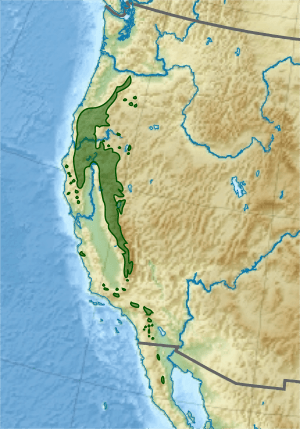Calocedrus decurrens facts for kids
Quick facts for kids Calocedrus decurrens |
|
|---|---|
 |
|
| Tree in Yosemite National Park, California | |
| Conservation status | |
| Scientific classification | |
| Genus: |
Calocedrus
|
| Species: |
decurrens
|
 |
|
| Distribution of Calocedrus decurrens in the Western United States | |
| Synonyms | |
|
|
Calocedrus decurrens, with the common names incense cedar and California incense-cedar (syn. Libocedrus decurrens Torr.), is a species of conifer native to western North America. It is the most widely known species in the genus, and is often simply called 'incense cedar' without the regional qualifier.
Contents
Description
Calocedrus decurrens is a large tree, typically reaching heights of 40–60 m (130–195 ft) and a trunk diameter of up to 1.2 m (3.9 ft). The largest known tree, located in Klamath National Forest, Siskiyou County, California, is 157.42 ft (47.98 m) tall with a 472-inch (12.0-meter) circumference trunk and a 57.42-foot (17.50-meter) spread. It has a broad conic crown of spreading branches. The bark is orange-brown weathering grayish, smooth at first, becoming fissured and exfoliating in long strips on the lower trunk on old trees.
The foliage is produced in flattened sprays with scale-like leaves 2–15 mm (3⁄32–19⁄32 in) long; they are arranged in opposite decussate pairs, with the successive pairs closely then distantly spaced, so forming apparent whorls of four; the facial pairs are flat, with the lateral pairs folded over their bases. The leaves are bright green on both sides of the shoots with only inconspicuous stomata. The foliage, when crushed, gives off an aroma somewhat akin to shoe-polish.
The seed cones are 20–35 mm (3⁄4–1+3⁄8 in) long, pale green to yellow, with four (rarely six) scales arranged in opposite decussate pairs; the outer pair of scales each bears two winged seeds, the inner pair(s) usually being sterile and fused together in a flat plate. The cones turn orange to yellow-brown when mature about 8 months after pollination. The pollen cones are 6–8 mm (1⁄4–5⁄16 in) long.
Distribution
The bulk of the range is in the United States, from central western Oregon through most of California and the extreme west of Nevada, and also a short distance into northwest Mexico in northern Baja California.
It grows at altitudes of 50–2,900 metres (160–9,510 ft)
Ecology
This tree is the preferred host of a wood wasp, Syntexis libocedrii a species which lays its eggs in the smoldering wood immediately after a forest fire. The tree is also host to incense-cedar mistletoe (Phoradendron libocedri), a parasitic plant which can often be found hanging from its branches.
The incense cedar is one of the most fire and drought tolerant plants in California. Although the tree is killed by hot, stand-replacing crown fire, it spreads rapidly after lower intensity burns. This has given the incense cedar a competitive advantage over other species such as the bigcone Douglas-fir in recent years.
Uses
The wood is the primary material for wooden pencils, because it is soft and tends to sharpen easily without forming splinters.
Native Americans
The Native Americans of California use the plant in traditional medicine, basket making, hunting bows, building materials, and to produce fire by friction.
The Maidu Concow tribe name for the plant is hö'-tä (Konkow language).
Cultivation
Calocedrus decurrens is cultivated by plant nurseries as an ornamental tree, for planting in gardens and parks. It is used in traditional, xeriscapic, native plant, and wildlife gardens; and used in designed natural landscaping and habitat restoration projects in California. It is valued for its columnar form and evergreen foliage textures.
The tree is also grown in gardens and parks in cool summer climates, including the Pacific Northwest in the Northwestern United States and British Columbia, eastern Great Britain and continental Northern Europe. In these areas it can develop an especially narrow columnar crown, an unexplained consequence of the cooler climatic conditions that is rare in trees within its warm summer natural range in the California Floristic Province. Other cultivated species from the family Cupressaceae can have similar crown forms. This plant has gained the Royal Horticultural Society's Award of Garden Merit, as has the cultivar 'Berrima Gold'.
Gallery
-
Incense cedar tree in McMinnville, Oregon
-
Incense cedar trunks in Lassen Volcanic National Park, California.
Images for kids
See also
 In Spanish: Libocedro de California para niños
In Spanish: Libocedro de California para niños









